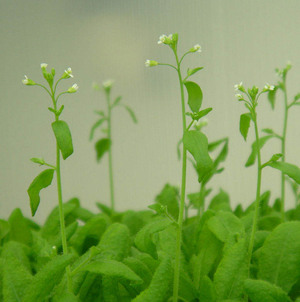May 25, 2007 Research Highlight Biology
Honing in on plant ‘flavor’
Researchers combine techniques to pinpoint a metabolic pathway in plants
 Figure 1: Seedlings of Arabidopsis thaliana.
Figure 1: Seedlings of Arabidopsis thaliana.
Researchers at the RIKEN Plant Science Center in Yokohama have identified the enzyme responsible for a key step in the synthesis of secondary metabolites in the mustard plant, Arabidopsis thaliana (Fig. 1). They used a combination of techniques including transcriptomics, metabolomics, reverse genetics and biochemical analyses.
Secondary metabolites are small organic compounds that are not directly necessary for the normal health of an organism, but are typically derived enzymatically from primary metabolites. They can help the organism defend itself from predators or, in the case of plants, add color to its blooms and thus aid in pollination. Several of the plant-derived secondary metabolites, including flavonoids, also have potential medicinal effects.
Based on published information about the flavonoid biosynthetic pathway in Arabidopsis, the research team, led by Kazuki Saito, suspected the existence of a certain type of enzyme in the process. To confirm their theory, the researchers needed to identify the gene encoding this enzyme—a challenge considering that there were 107 candidates, as judged by analysis of the complete sequence of the Arabidopsis genome.
Initially, the team used publicly available databases that describe the expression patterns of the Arabidopsis genome to look for appropriate regulatory and enzymatic genes that are co-expressed in the flavonoid biosynthetic pathway across a wide-range of tissues and growth conditions. This transcriptomic analysis narrowed the candidate pool to four genes. One of these genes, UGT89C1, encodes a protein that also has strong amino acid sequence homology to similar enzymes involved in different biological processes, so the researchers used metabolomics to analyze the flavonoid profiles of mutant Arabidopsis strains lacking the expression of UGT89C1. These mutants were deficient in flavonoids generated by the enzyme that the team hypothesized to exist. This combination of metabolomics and reverse genetics indicated that UGT89C1 encoded for the suspected enzyme1.
The team then validated the function of this enzyme by showing that it behaves as expected when purified and tested in a test tube, that re-expression of the normal gene in the UGT89C1 mutant strains restored normal levels of the missing flavonoids, and that the enzyme was expressed in the parts of the plant where the particular flavonoids occurred.
Saito believes "these results point to a proof-of-principle that combining several techniques will allow researchers to find a needle in a biological haystack”, especially given the improvement in analytical techniques and public databases. He is particularly excited by the combination of transcriptomics with metabolomics, which may further reveal complete metabolic pathways and their regulators.
References
- 1. Yonekura-Sakakibara, K., Tohge, T., Niida, R. & Saito, K. Identification of a flavonol 7-O-rhamnosyltransferase gene determining flavonoid pattern in Arabidopsis by transcriptome coexpression analysis and reverse genetics. Journal of Biological Chemistry 282, 14932–14941 (2007). doi: 10.1074/jbc.M611498200
